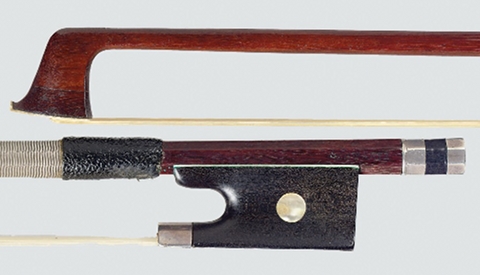GEORGE FREDERIC SCHWARTZ; THE MESTIZO
When someone goes through history they mostly leave their own personal interpretation of events and personalities. This might be the reason to why a great craftsman like George Frédéric Schwartz has almost been forgotten.

Violin bow by George Frédéric Schwartz
George Frédéric Schwartz was born on the 7th of April 1785 in Strasbourg. He was the son of Bernard Schwartz, who started out as a carpenter and went on to be a violin maker, and Marguerite Salomé Euler. George Frédéric was one of those craftsmen of whom one doesn't know who his teacher was. He must have done the first apprenticeship by his father, in fact he did make some violins in his carrier, though his principal activity was bow making.
We don't know who his teacher was, and we don't know much about his life. A part the fact that he married twice; first Francoise Barbe Gugelmann, second with Sophie Dorothée Buhner.
The mystery of Schwartz' life is interesting because of the level of his work. You might remember Gaulard. From a structural point of view the work of Gaulard results as being about twenty years back in time compared to the bows made by Schwartz, even though Gaulard was two years younger than Schwartz.
Whereas Gaulard remained attached to the style of his master, Louis Simon Pajeot, Schwartz made heads which was much more sophisticated and his frogs came closer to modern dimensions; the throat was less profound and the octagon was covered in a drawstring in silver - both adjustments to obtain a stronger structure.
But then who thought Schwartz to work so well? I believe the answer is to be found by seeking his origins. He was born in Strasbourg, the only French city that can not expand east; Germany is in the way!
Looking at Schwartz' work - the heads and the frogs - you will find some peculiarities from the German school. The wedge of the heads are slide backwoods more than the French ones of the period and the frogs recall the work done by the Knopf family. Schwartz used one of the families technics in the gold mounting.
As gold is a very expensive material, the ring and the other metal parts on the bow are made of a copper core covered by gold sheets; a technic used by the Knopfs and by the russian Kittel.
If we know very little about the beginning, we know about the same about the rest of the life of Schwartz. Even though he worked for atleast fifty years, the bows made by this Sir are very rare, so much so that I have had to pick the initial photo from the web.
We don't know if he worked for someone, even though it seems likely. “L'Archet” quote that the style Schwartz gained in the years approached the style of the Peccatte school. The book doesn't mention any collaboration though. Strange; usually it is known by whom a craftsman work.
Some years ago, a client of mine showed me a Francois Peccatte - fortunately not certificated by a Frenchman. It seems unbelievable but it looked very much like a Schwartz; and I say looked like because it probably wasn't. Let's go on with history and I will explain.
George Frédéric Schwartz died on the 29th of December 1850 in Strasbourg. Two years later on his nephew Théophile Wilhelm took over the workshop and kept on selling bows, marking them “SCHWARTZ” on the left side, very near to the button, and “STRASBOURG” on the right side, in the same position.
Now, Théophile Wilhelm was not a bow maker and he was therefore forced to buy the bows in various production centres in France and in Germany.
The bow of my client is not marked, and that might be due to the type of product. The bow is made in Bois d'Amourette, and the frog is made in nickel silver. Bois d'Amourette is a less precious wood than the Pernambuco, and this type of wood was used mainly to make more simple bows. This product was probably sold to a smaller market without an official mark. It does look very much like the work of Schwartz.
I believe it is likely that Schwartz worked for someone, maybe a big name; like Pajeot. Schwartz had an excellent hand and I am sure that his work was admired by more than one craftsman in that period. Never the less remains one of the less known craftsmen, and his bows are quite rare.
Is the reason to the French ostracism his mestizo origin?
So long,
Paolo
|